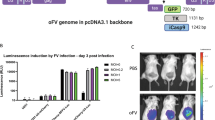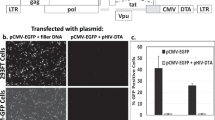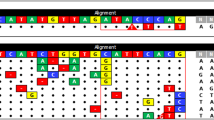Abstract
As serious side effects affected recent virus-mediated gene transfer studies, novel vectors with improved safety profiles are urgently needed. In the present study, replication-deficient retroviral vectors based on feline foamy virus (FFV) were constructed and analyzed. The novel FFV vectors are devoid of almost the complete env gene plus the internal promoter – accessory bel gene cassette including the gene for the viral transcriptional transactivator Bel1/Tas. In these Bel1/Tas-independent vectors, expression of the lacZ (β-galactosidase) marker gene is directed by the heterologous, constitutively active human ubiquitin C promoter (ubi). Env-transcomplemented vectors have un-concentrated titers of more than 105 transducing units/ml. The vectors allow efficient transduction of a broad array of diverse target cells, which can be increased by repeated vector exposure. However, the number of lacZ marker gene expressing cells decreased slightly upon serial passages of the transduced cells. Vectors carrying a self-inactivating (SIN) deletion of the TATA box and most parts of the viral promoter were not rescued by wt FFV whereas those with the intact or a partially deleted promoter were readily reactivated. This finding indicates that the viral promoters are in fact non-functional, pointing to a highly advantageous safety profile of these new FFV-ubi-lacZ-SIN vectors.
This is a preview of subscription content, access via your institution
Access options
Subscribe to this journal
Receive 12 print issues and online access
$259.00 per year
only $21.58 per issue
Buy this article
- Purchase on Springer Link
- Instant access to full article PDF
Prices may be subject to local taxes which are calculated during checkout




Similar content being viewed by others
References
Verma IM, Weitzman MD . Gene therapy: twenty-first century medicine. Annu Rev Biochem 2005; 74: 711–738.
Baum C, von Kalle C, Staal FJ, Li Z, Fehse B, Schmidt M et al. Chance or necessity? Insertional mutagenesis in gene therapy and its consequences. Mol Ther 2004; 9: 5–13.
Pandya S, Klimatcheva E, Planelles V . Lentivirus and foamy virus vectors: novel gene therapy tools. Expert Opin Biol Ther 2001; 1: 17–40.
Bastone P, Löchelt M . Kinetics and characteristics of replication-competent revertants derived from self-inactivating foamy virus vectors. Gene Therapy 2004; 11: 465–473.
Schwantes A, Ortlepp I, Löchelt M . Construction and functional characterization of feline foamy virus-based retroviral vectors. Virology 2002; 301: 53–63.
Schwantes A, Truyen U, Weikel J, Weiss C, Löchelt M . Application of chimeric feline foamy virus-based retroviral vectors for the induction of antiviral immunity in cats. J Virol 2003; 77: 7830–7842.
Leurs C, Jansen M, Pollok KE, Heinkelein M, Schmidt M, Wissler M et al. Comparison of three retroviral vector systems for transduction of nonobese diabetic/severe combined immunodeficiency mice repopulating human CD34(+) cord blood cells. Hum Gene Therapy 2003; 14: 509–519.
Heinkelein M, Hoffmann U, Lucke M, Imrich H, Müller JG, Meixensberger J et al. Experimental therapy of allogeneic solid tumors induced in athymic mice with suicide gene-transducing replication-competent foamy virus vectors. Cancer Gene Therapy 2005; 12: 947–953.
Mergia A, Heinkelein M . Foamy virus vectors. Curr Top Microbiol Immunol 2003; 277: 131–159.
Moore MD, McGarvey MJ, Russel RA, Cullen BR, McClure MO . Stable inhibition of hepatitis B virus proteins by small interfering RNA expressed from viral vectors. J Gene Med 2005; 7: 918–925.
Josephson NC, Trobridge G, Russell DW . Transduction of long-term and mobilized peripheral blood-derived NOD/SCID repopulating cells by foamy virus vectors. Hum Gene Therapy 2004; 15: 87–92.
Josephson NC, Vassilopoulos G, Trobridge GD, Priestley GV, Wood BL, Papayannopoulou T et al. Transduction of human NOD/SCID-repopulating cells with both lymphoid and myeloid potential by foamy virus vectors. Proc Natl Acad Sci USA 2002; 99: 8295–8300.
Trobridge G, Vassilopoulos G, Josephson N, Russell DW . Gene transfer with foamy virus vectors. Methods Enzymol 2002; 346: 628–648.
Heneine W, Schweizer M, Sandstrom P, Folks T . Human infection with foamy viruses. Curr Top Microbiol Immunol 2003; 277: 181–196.
Saib A . Non-primate foamy viruses. Curr Top Microbiol Immunol 2003; 277: 197–211.
Linial ML . Foamy viruses are unconventional retroviruses. J Virol 1999; 73: 1747–1755.
Falcone V, Schweizer M, Neumann-Haefelin D . Replication of primate foamy viruses in natural and experimental hosts. Curr Top Microbiol Immunol 2003; 277: 161–180.
Trobridge GD, Miller DG, Jacobs MA, Allen JM, Kiem HP, Kaul R et al. Foamy virus vector integration sites in normal human cells. Proc Natl Acad Sci USA 2006; 103: 1498–1503.
Nowrouzi A, Dittrich M, Klanke C, Heinkelein M, Rammling M, Dandekar T et al. Genome-wide mapping of foamy virus vector integrations into a human cell line. J Gen Virol 2006; 87: 1339–1347.
Bastone P, Bravo IG, Löchelt M . Feline foamy virus-mediated marker gene transfer: identification of essential genetic elements and influence of truncated and chimeric proteins. Virology 2006; 348: 190–199.
Löchelt M . Foamy virus transactivation and gene expression. Curr Top Microbiol Immunol 2003; 277: 27–61.
Löchelt M, Romen F, Bastone P, Muckenfuss H, Kirchner N, Kim Y-B et al. The antiretroviral activity of APOBEC3 is inhibited by the foamy virus accessory Bet protein. Proc Natl Acad Sci USA 2005; 102: 7982–7987.
Alke A, Schwantes A, Zemba A, Flügel R-M, Löchelt M . Characterization of the humoral immune response and virus replication in cats experimentally infected with feline foamy virus. Virology 2000; 275: 170–176.
Pietschmann T, Heinkelein M, Heldmann M, Zentgraf H, Rethwilm A, Lindemann D . Foamy virus capsids require the cognate envelope protein for particle export. J Virol 1999; 73: 2613–2621.
Baldwin DN, Linial ML . The roles of Pol and Env in the assembly pathway of human foamy virus. J Virol 1998; 72: 3658–3665.
Zemba M, Alke A, Bodem J, Winkler IG, Flower RLP, Pfrepper K-I et al. Construction of infectious feline foamy virus genomes: cat antisera do not cross-neutralize feline foamy virus chimera with serotype-specific Env sequences. Virology 2000; 266: 150–156.
Trobridge G, Josephson N, Vassilopoulos G, Mac J, Russell DW . Improved foamy virus vectors with minimal viral sequences. Mol Ther 2002; 6: 321–328.
Flower RL, Wilcox GE, Cook RD, Ellis TM . Detection and prevalence of serotypes of feline syncytial spumaviruses. Arch Virol 1985; 83: 53–63.
Lindemann D, Pietschmann T, Picard-Maureau M, Berg A, Heinkelein M, Thurow J et al. A particle-associated glycoprotein signal peptide essential for virus maturation and infectivity. J Virol 2001; 75: 5762–5771.
Wilk T, Geiselhart V, Frech M, Fuller SD, Flügel RM, Löchelt M . Specific interaction of a novel foamy virus Env leader protein with the N-terminal Gag domain. J Virol 2001; 75: 7995–8007.
Cronin J, Zhang XY, Reiser J . Altering the tropism of lentiviral vectors through pseudotyping. Curr Gene Therapy 2005; 5: 387–398.
Schorpp M, Jager R, Schellander K, Schenkel J, Wagner EF, Weiher H et al. The human ubiquitin C promoter directs high ubiquitous expression of transgenes in mice. Nucleic Acids Res 1996; 24: 1787–1788.
Bonnerot C, Rocancourt D, Briand P, Grimber G, Nicolas J-F . A beta-galactosidase hybrid protein targeted to nuclei as a marker for developmental studies. Proc Natl Acad Sci USA 1987; 84: 6795–6799.
Alke A, Schwantes A, Kudo K, Flötenmeyer M, Flügel RM, Löchelt M . The bet gene of feline foamy virus is required for virus replication. Virology 2001; 287: 310–320.
Marx JC, Allay JA, Persons DA, Nooner SA, Hargrove PW, Kelly PF et al. High-efficiency transduction and long-term gene expression with a murine stem cell retroviral vector encoding the green fluorescent protein in human marrow stromal cells. Hum Gene Therapy 1999; 10: 1163–1173.
Mitchell RS, Beitzel BF, Schroder AR, Shinn P, Chen H, Berry CC et al. Retroviral DNA integration: ASLV, HIV, and MLV show distinct target site preferences. PLoS Biol 2004; 2: E234.
Gill DR, Smyth SE, Goddard CA, Pringle IA, Higgins CF, Colledge WH et al. Increased persistence of lung gene expression using plasmids containing the ubiquitin C or elongation factor 1alpha promoter. Gene Therapy 2001; 8: 1539–1546.
O'Brien SJ, Menotti-Raymond M, Murphy WJ, Yuhki N . The feline genome project. Annu Rev Genet 2002; 36: 657–686.
Bock M, Heinkelein M, Lindemann D, Rethwilm A . Cells expressing the human foamy virus (HFV) accessory Bet protein are resistant to productive HFV super-infection. Virology 1998; 250: 194–204.
Roy J, Rudolph W, Juretzek T, Gärtner K, Bock M, Herchenröder O et al. Feline foamy virus genome and replication strategy. J Virol 2003; 77: 11324–11331.
Callahan SM, Boquet MP, Ming X, Brunner LJ, Croyle MA . Impact of transgene expression on drug metabolism following systemic adenoviral vector administration. J Gene Med 2006; 8: 566–567.
Wagner A, Doerks A, Aboud M, Alonso M, Tokino T, Flügel RM et al. Induction of cellular genes is mediated by the Bel1 transactivator in foamy virus-infected human cells. J Virol 2000; 74: 4441–4447.
Berger J, Hauber J, Hauber R, Geiger R, Cullen BR . Secreted placental alkaline phosphatase: a powerful new quantitative indicator of gene expression in eukaryotic cells. Gene 1988; 66: 1–10.
Winkler I, Bodem J, Haas L, Zemba M, Delius H, Flower RP et al. Characterization of the genome of feline foamy virus and its proteins shows distinct features different from those of primate spumaviruses. J Virol 1997; 71: 6727–6741.
Geiselhart V, Schwantes A, Bastone P, Frech M, Löchelt M . Features of the Env leader protein and the N-terminal Gag domain of feline foamy virus important for virus morphogenesis. Virology 2003; 310: 235–244.
Acknowledgements
We thank JF Nicolas (Institut Pasteur, Paris), A Alonso and B Hartenstein (DKFZ) for plasmid constructs and L Gissmann (DKFZ) for continuous support.
Author information
Authors and Affiliations
Corresponding author
Rights and permissions
About this article
Cite this article
Bastone, P., Romen, F., Liu, W. et al. Construction and characterization of efficient, stable and safe replication-deficient foamy virus vectors. Gene Ther 14, 613–620 (2007). https://doi.org/10.1038/sj.gt.3302890
Received:
Revised:
Accepted:
Published:
Issue Date:
DOI: https://doi.org/10.1038/sj.gt.3302890
Keywords
This article is cited by
-
Replacement of feline foamy virus bet by feline immunodeficiency virus vif yields replicative virus with novel vaccine candidate potential
Retrovirology (2018)
-
Immunisation with foamy virus Bet fusion proteins as novel strategy for HIV-1 epitope delivery
Immunologic Research (2013)
-
Progress and prospects: Foamy virus vectors enter a new age
Gene Therapy (2010)



